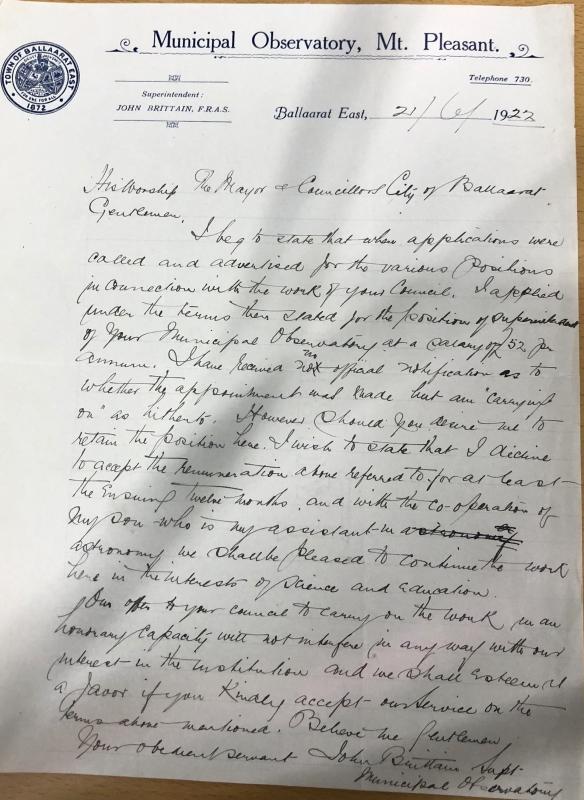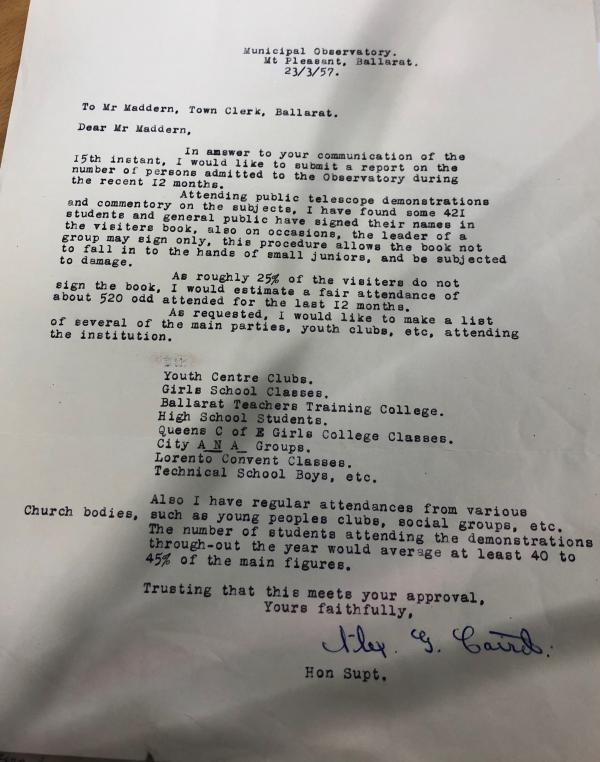
Author: Marlene Cantwell
Access Services Officer, Ballarat Archives Centre
When Ballarat comes to mind, one’s immediate thoughts often revolve around its rich history in gold mining.
Undoubtedly, the discovery of gold spurred engineering innovations and breakthroughs, which, in turn, played a significant role in the establishment of the Ballarat Municipal Observatory. Nevertheless, behind this pivotal moment was a group of forward-thinking pioneers from the Ballarat community. These individuals were driven by a passion for science, the arts, and education, and utilised their wealth, knowledge, and expertise to initiate and establish institutions that benefited the entire community. Among these notable figures were James Oddie, Captain Henry Evans Baker, and John Brittain. Their collective contributions were instrumental in shaping the early history and development of the municipal observatory.
The Ballarat Municipal Observatory holds a unique distinction as possibly the sole surviving nineteenth-century private observatory, and notably, it was the inaugural municipal observatory in Australia. It first opened in 1886,1 followed by a formal ceremony in 1888.2
A detailed description of the observatory, including its structures and instruments, can be found in a Ballarat Star article from December 1866.3 The observatory additionally played a pivotal role in the establishment of the Commonwealth Observatory (Mt Stromlo). In 1910, James Oddie, facing significant financial setbacks stemming from the crash of the 1890s, donated some of the observatory’s equipment to Mt. Stromlo. Despite his inability to sustain funding from the Ballarat Council for the observatory,4 Oddie’s contribution, particularly his donation of a 9-inch refractor telescope, served as the cornerstone for the Commonwealth observatory at Mt. Stromlo.
The inception of the Oddie Observatory traces back to the visionary efforts and sole funding provided by James Oddie. In 1884, Oddie lobbied the government for the allocation of three acres of land on Cobden Street, Mount Pleasant, to be reserved for the establishment of an observatory under the School of Mines. Over the years, the observatory underwent several name changes, including Oddie Observatory, Mount Pleasant Observatory, and the School of Mines Observatory. These name alterations mirror its tumultuous past and ongoing struggle for survival. The following paragraphs explore the lives of the pioneers whose contributions were instrumental in both its establishment and subsequent revival.
James Oddie (1824-1911)
James Oddie arrived in Geelong from England aboard the “Larpent” on June 28, 1849. A product of the Victorian industrialisation era and a devout Wesleyan, Oddie was born on March 31, 1824, in Clitheroe, Lancashire. Establishing himself as a successful storekeeper and auctioneer in Ballarat, Oddie made history as the first Ballarat municipal chairman, elected on January 14, 1856.5
Driven by his profound religious convictions, Oddie rose to prominence as a successful businessman and became the driving force behind the establishment of numerous iconic organisations in Ballarat. His philanthropic endeavours knew no bounds, as evidenced by his founding of the Ballarat Art Gallery in 1884. Additionally, he served as a trustee and Vice President of the School of Mines Council in 1881 and was a dedicated board member of the Benevolent Asylum for over three decades. Oddie also played a crucial role in the establishment of the National Schools of Ballarat, leaving an indelible mark on the educational landscape of the region.
Captain Henry Evans Baker (1816 – 1890)
Captain Henry Evans Baker was a remarkable individual, sharing many similarities with Oddie as a devout Wesleyan who believed in self-betterment. He arrived in Melbourne with his new bride in March 1853, serving as the captain of the “John Scott.”6 Following the sale of the “John Scott” vessel, he transitioned to mining and relocated to the Goldsborough goldfields. There, he founded the Goldsborough Company and distinguished himself through the invention and repair of mining and agricultural tools.
In addition to his practical endeavours, Captain Baker shared his astronomical knowledge with the local community. Using telescopes that he personally constructed, he strived to popularise astronomy among the communities’ residents. His talents did not go unnoticed, as he was recommended to Oddie by R. J. Ellery, an astronomer at the Melbourne Observatory. Consequently, Captain Baker was appointed as the first superintendent of the observatory, leveraging his expertise in physics, mathematics, and telescope manufacturing.
A testament to his mechanical prowess, a quote from the “Ballarat Star” on June 14, 1890, lauded Baker’s abilities:
“His mechanical ability almost amounted to genius.”7
Establishing a foundry and workshop at the observatory, Captain Baker focused on building and maintaining telescopes. Notably, the 12 ½-inch telescope, displayed at the Melbourne Exhibition of 1873, which earned him a silver medal. However, his crowning achievement was the construction of the Newtonian 26-inch reflector telescope, known as the Baker Great Equatorial Telescope (unveiled in 1888). It was the first large telescope manufactured in Australia. Captain Baker’s legacy endured through his leadership during the formative years of the Oddie Observatory. His death in June 1890 marked the end of an era, leaving behind a lasting impact on the observatory and the field of astronomy in Australia.
John Brittain (1860-1943)
Following Captain Baker’s death, the observatory’s equipment and structures fell into a state of disrepair.
Despite Oddie’s efforts to persuade the council to assume responsibility for the observatory, their refusal in 1903 prompted Oddie to dismantle the buildings. Subsequently, he donated the astronomical equipment to the Commonwealth Observatory at Mount Stromlo in 1910.
Upon Oddie’s death in 1911, John Brittain, acting on behalf of the School of Mines, spearheaded the campaign for the observatory’s restoration. Correspondence files from the Ballarat Council in the Public Record Office (PROV) shed light on the historical letters exchanged in 1912 and 1913, documenting the Ballarat East Council’s takeover of the observatory.8
John Brittain, born in 1860 in Pyle, Glamorganshire, Wales, migrated to Australia with his family in 1870, settling in Mount Pleasant, Ballarat. Initially working as a miner, he later pursued photography and eventually became a lecturer in astronomy and surveying at the Ballarat School of Mines. Brittain also held the position of Vice President at the Ballarat School of Mines Field Naturalists Club. A man of deep religious conviction and considerable astronomical expertise, Brittain demonstrated a strong commitment to community service. He served as a health inspector and municipal valuer for the Ballarat East Council. In recognition of his contributions to the field of astronomy, Brittain was elected as a member of the Astronomical Society of France in 1910 and later became a life member of the Royal Astronomical Society of Great Britain in 1941.9
After thirty years of dedicated service to the observatory, Brittain died in Ballarat in 1943. During his time as superintendent, he revived the observatory, making significant improvement to the buildings and maintenance of the telescopes.
He appealed to the community for donations to beautify the buildings and to help with the cost of scientific equipment, to which the community generously responded. It was during his time as superintendent that the iconic stained-glass windows were installed; donated by the Welsh community and other local organisations.10 During Brittain’s tenure as superintendent, the observatory acquired an additional telescope using the donation of a local engineering company. The Jelbart Brothers facilitated the acquisition of a modern 5-inch Cooke refractor, valued at £250.11
Brittain championed public education in astronomy, demonstrating his commitment through various means. He contributed articles on astronomy to the local newspaper, delivered public lectures, and provided meteorological data published in local newspapers. Such was his dedication to the public observatory that in 1922, he offered to forgo his salary for a year:
“In the interests of science and education.”12
The letter dated 1922, cited below, was sourced from the Ballarat Council General Correspondence files, VPRS 2500, housed within the PROV Ballarat collection.
Following Brittain’s death in 1943, the observatory was without supervision until the appointment of Alexander Caird in 1947. Caird, an enthusiastic and dedicated superintendent, wasted no time in initiating the rehabilitation of the observatory’s buildings and instruments. Correspondence files from the Ballarat City Council highlight the significant role played by the observatory in popularizing astronomy within the Ballarat community. A Mayoral report from Caird in 1957 provides detailed insights into the observatory’s impact, including the number of visitors it attracted over the course of a year.
In 1957, following Caird's death, the Astronomical Society of Victoria recognised the importance of preserving the observatory’s buildings and instruments. Consequently, in 1958, they facilitated the establishment of the Ballarat Astronomical Society (BAS). Comprised of dedicated volunteers, the BAS now oversees the management of the facility, diligently upholding the legacy left by the early pioneers of the observatory through the organization of regular community events.
Moreover, the preservation of the observatory has been significantly bolstered by the unwavering support of the Ballarat community over the years. Their significant contributions and enduring community spirit have played a pivotal role in ensuring the observatory’s continued existence and relevance.
References:
1. “The Mount Pleasant Observatory” (1886, May 12). The Ballarat Star (page 4). Retrieved from: https://trove.nla.gov.au/newspaper/article/204431607?searchTerm=Mount%20Pleasant%20Observatory
2. “Opening of the Mount Pleasant Observatory” (1888, March 3). The Ballarat Star (page 4). Retrieved from: https://trove.nla.gov.au/newspaper/article/209213928?searchTerm=The%20opening%20of%20the%20observatory
3. The Ballarat Observatory” (1886, December 15). The Ballarat Star (page 3). Retrieved from: https://trove.nla.gov.au/newspaper/article/210839762?searchTerm=Oddie%20Observatory
4. “The Oddie Observatory: Offered to the City Council: The gift declined (1903, April 28). The Ballarat Star (page 6). Retrieved from: https://trove.nla.gov.au/newspaper/article/208468742?searchTerm=Oddie%20Observatory
5. “Death of Mr. James Oddie” (1911, March 4). The Ballarat Star, (page 1). Retrieved from: https://trove.nla.gov.au/newspaper/article/216628336?searchTerm=James%20Oddie
6. PROV, VPRS 947/P0000 Jan-March 1853. Inward Overseas Passenger List.
7. “In Memoriam: Henry Evans Baker” (1890, June 14). The Ballarat Star (page 1). Retrieved from: https://trove.nla.gov.au/newspaper/article/209707349?searchTerm=Captain%20Henry%20Evans%20Baker
8. PROV, VPRS 2500/P0000; Mount Pleasant Observatory
9. Astronomical Society” (1941, November 27). The Argus (page 3). Retrieved from: https://trove.nla.gov.au/newspaper/article/8219211?searchTerm=John%20Brittain
10. “Ornate Observatory Windows” (1916, April 13). The Evening Echo (page 4). Retrieved from: https://trove.nla.gov.au/newspaper/article/241392188?searchTerm=The%20astronomical%20observatory%20Ballarat
11. “Municipal Observatory: A generous gift: Up-to-date telescope” (1916, June 13). The Ballarat Courier (page 1). Retrieved from: https://trove.nla.gov.au/newspaper/article/74514773?searchTerm=The%20Jelbart%20telescope
12. PROV, VPRS 2500/P0000, Mount Pleasant Observatory 1922
Material in the Public Record Office Victoria archival collection contains words and descriptions that reflect attitudes and government policies at different times which may be insensitive and upsetting
Aboriginal and Torres Strait Islander Peoples should be aware the collection and website may contain images, voices and names of deceased persons.
PROV provides advice to researchers wishing to access, publish or re-use records about Aboriginal Peoples









